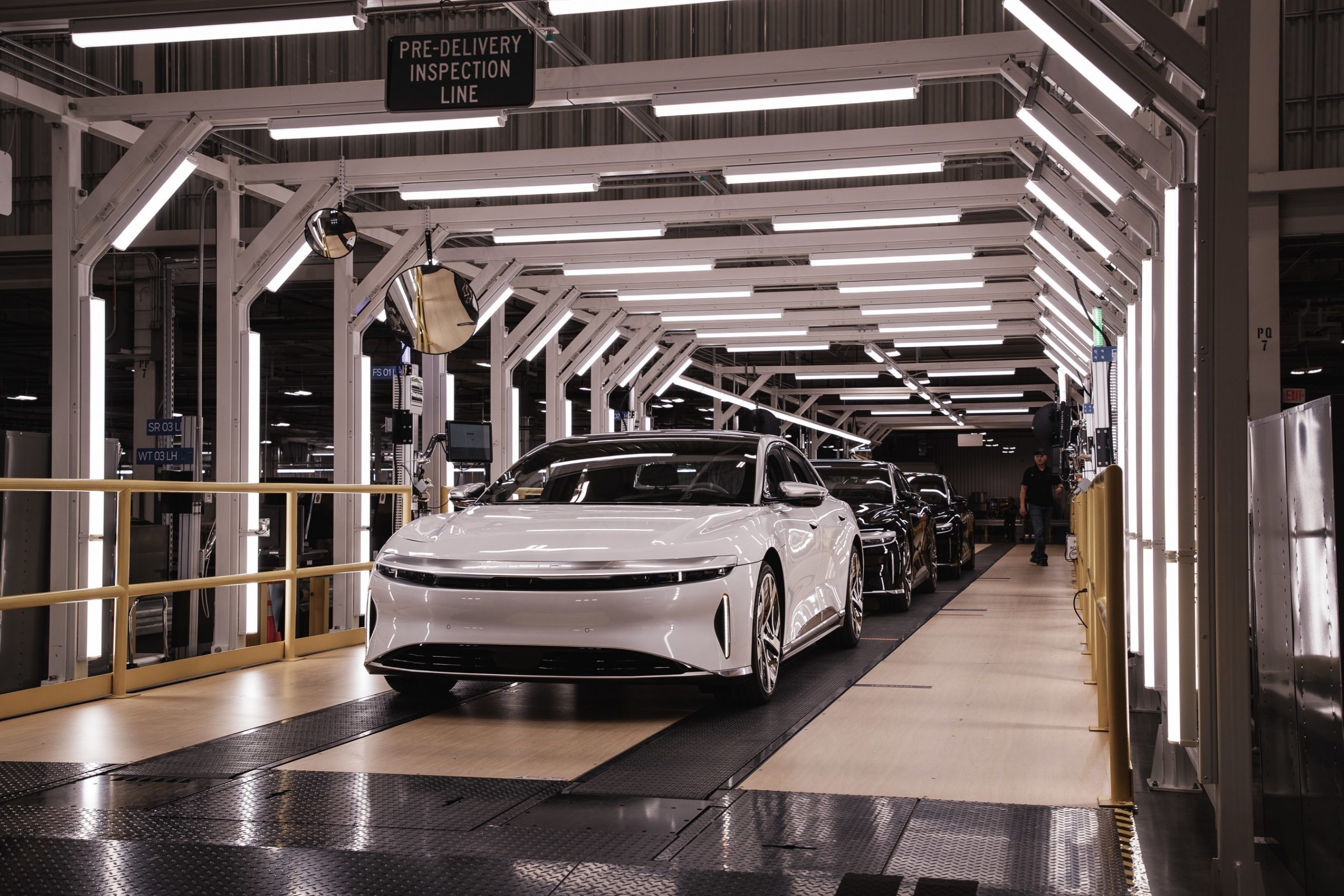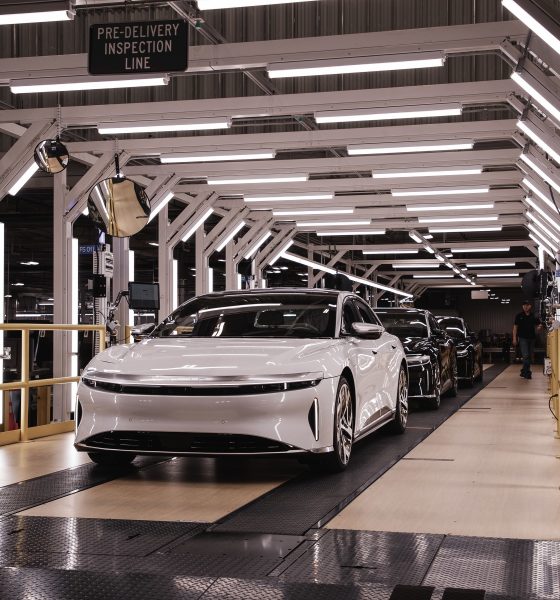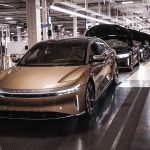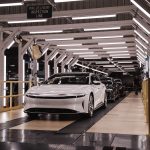

News
Lucid begins production of Air sedan, expects October for first deliveries
Lucid Group has announced that it will begin delivering its first sedan, the Air Dream Edition sedan, in October. Production of the Air has begun, according to the automaker, who is holding a Production Preview Event this week at its Casa Grande, Arizona, manufacturing facility.
The first units of the Air Dream Edition sedan rolled off of the Lucid assembly lines earlier today, and Arizona Governor Doug Ducey was in attendance for the event. Lucid has been a catalyst for job creation and economic development, increasing the area’s high-tech footprint for manufacturing. The site is expected to generate around $9 billion in economic output in 2024, along with 15,000 new jobs every year by the same date.
The production preview event also gave attendees, which
included media members, customers, investors, and others the opportunity to drive the Air sedan, which is expected to be delivered for the first time in late October.
- The first customer-quality Lucid Air luxury electric sedans rolled off the assembly line today at Lucid’s Advanced Manufacturing Plant (AMP-1) in Casa Grande, AZ, which included a factory commissioning ceremony with Arizona Governor Doug Ducey.
- Lucid expects reservation holders of Lucid Air Dream Edition models will begin receiving their vehicles in late October, with customer deliveries ramping up thereafter. Grand Touring, Touring, and Air Pure model deliveries are expected to follow. Lucid has thus far received more than 13,000 reservations for Lucid Air and increased the planned total production quantity of the Dream Edition to 520 vehicles.
Lucid said in a press release that it expected reservation holders to start seeing deliveries in the later portions of October, but only for the Dream Edition sedan, the vehicle’s premier trim. After initial deliveries of the Dream Edition trim begin, they will be followed with the Grand Touring, Touring, and Air Pure deliveries. Lucid has received over 13,000 reservations for the Air across its various trim levels and packages, which has increased the company’s projected output of Dream Edition sedans from around 500 to 520. Interestingly, this number also coincides with the vehicle’s EPA-estimated range ratings, which were released last week.
Lucid Air Dream gets massive 520-mile range rating in preliminary EPA tests
The EPA gave the Air Dream Edition an industry-leading 520 miles per charge in testing, holding a considerable lead over the Tesla Model S Long Range. Lucid holds an over 100-mile lead in range ratings, giving the company a significant advantage over its closest competitors. This statistic alone could drive Lucid to become a disruptor in the evergrowing United States electric vehicle sector. “With customer-quality cars now coming off the line, Lucid has confirmed that the Air meets all the applicable regulatory requirements from the EPA and U.S. Department of Transportation,” Lucid Group wrote in a statement.
“The proprietary EV technology that Lucid has developed will make it possible to travel more miles using less battery energy,” company CEO and CTO Peter Rawlinson said. “For example, our Lucid Air Grand Touring has an official EPA rating of 516 miles of range with a 112-kWh battery pack, giving it an industry-leading efficiency of 4.6 miles per kWh. Our technology will allow for increasingly lighter, more efficient, and less expensive EVs, and today represents a major step in our journey to expand the accessibility of more sustainable transportation. I’m delighted that production cars endowed with this level of efficiency are currently driving off our factory line.”
Lucid’s next few years align with a plan for expansion of not only its production lines, but its facility in general. The company plans to expand its 590-acre site in Arizona by 2.85 million square feet, giving additional manufacturing room for Air sedans. Additionally, Lucid will expand its product line with the Gravity SUV.
What do you think? Let us know in the comments below, or be sure to email me at joey@teslarati.com or on Twitter @KlenderJoey.

Elon Musk
Elon Musk and Tesla AI Director share insights after empty driver seat Robotaxi rides
The executives’ unoccupied tests hint at the rapid progress of Tesla’s unsupervised Robotaxi efforts.

Tesla CEO Elon Musk and AI Director Ashok Elluswamy celebrated Christmas Eve by sharing personal experiences with Robotaxi vehicles that had no safety monitor or occupant in the driver’s seat. Musk described the system’s “perfect driving” around Austin, while Elluswamy posted video from the back seat, calling it “an amazing experience.”
The executives’ unoccupied tests hint at the rapid progress of Tesla’s unsupervised Robotaxi efforts.
Elon and Ashok’s firsthand Robotaxi insights
Prior to Musk and the Tesla AI Director’s posts, sightings of unmanned Teslas navigating public roads were widely shared on social media. One such vehicle was spotted in Austin, Texas, which Elon Musk acknowleged by stating that “Testing is underway with no occupants in the car.”
Based on his Christmas Eve post, Musk seemed to have tested an unmanned Tesla himself. “A Tesla with no safety monitor in the car and me sitting in the passenger seat took me all around Austin on Sunday with perfect driving,” Musk wrote in his post.
Elluswamy responded with a 2-minute video showing himself in the rear of an unmanned Tesla. The video featured the vehicle’s empty front seats, as well as its smooth handling through real-world traffic. He captioned his video with the words, “It’s an amazing experience!”
Towards Unsupervised operations
During an xAI Hackathon earlier this month, Elon Musk mentioned that Tesla owed be removing Safety Monitors from its Robotaxis in Austin in just three weeks. “Unsupervised is pretty much solved at this point. So there will be Tesla Robotaxis operating in Austin with no one in them. Not even anyone in the passenger seat in about three weeks,” he said. Musk echoed similar estimates at the 2025 Annual Shareholder Meeting and the Q3 2025 earnings call.
Considering the insights that were posted Musk and Elluswamy, it does appear that Tesla is working hard towards operating its Robotaxis with no safety monitors. This is quite impressive considering that the service was launched just earlier this year.
Elon Musk
Starlink passes 9 million active customers just weeks after hitting 8 million
The milestone highlights the accelerating growth of Starlink, which has now been adding over 20,000 new users per day.

SpaceX’s Starlink satellite internet service has continued its rapid global expansion, surpassing 9 million active customers just weeks after crossing the 8 million mark.
The milestone highlights the accelerating growth of Starlink, which has now been adding over 20,000 new users per day.
9 million customers
In a post on X, SpaceX stated that Starlink now serves over 9 million active users across 155 countries, territories, and markets. The company reached 8 million customers in early November, meaning it added roughly 1 million subscribers in under seven weeks, or about 21,275 new users on average per day.
“Starlink is connecting more than 9M active customers with high-speed internet across 155 countries, territories, and many other markets,” Starlink wrote in a post on its official X account. SpaceX President Gwynne Shotwell also celebrated the milestone on X. “A huge thank you to all of our customers and congrats to the Starlink team for such an incredible product,” she wrote.
That growth rate reflects both rising demand for broadband in underserved regions and Starlink’s expanding satellite constellation, which now includes more than 9,000 low-Earth-orbit satellites designed to deliver high-speed, low-latency internet worldwide.
Starlink’s momentum
Starlink’s momentum has been building up. SpaceX reported 4.6 million Starlink customers in December 2024, followed by 7 million by August 2025, and 8 million customers in November. Independent data also suggests Starlink usage is rising sharply, with Cloudflare reporting that global web traffic from Starlink users more than doubled in 2025, as noted in an Insider report.
Starlink’s momentum is increasingly tied to SpaceX’s broader financial outlook. Elon Musk has said the satellite network is “by far” the company’s largest revenue driver, and reports suggest SpaceX may be positioning itself for an initial public offering as soon as next year, with valuations estimated as high as $1.5 trillion. Musk has also suggested in the past that Starlink could have its own IPO in the future.
News
NVIDIA Director of Robotics: Tesla FSD v14 is the first AI to pass the “Physical Turing Test”
After testing FSD v14, Fan stated that his experience with FSD felt magical at first, but it soon started to feel like a routine.

NVIDIA Director of Robotics Jim Fan has praised Tesla’s Full Self-Driving (Supervised) v14 as the first AI to pass what he described as a “Physical Turing Test.”
After testing FSD v14, Fan stated that his experience with FSD felt magical at first, but it soon started to feel like a routine. And just like smartphones today, removing it now would “actively hurt.”
Jim Fan’s hands-on FSD v14 impressions
Fan, a leading researcher in embodied AI who is currently solving Physical AI at NVIDIA and spearheading the company’s Project GR00T initiative, noted that he actually was late to the Tesla game. He was, however, one of the first to try out FSD v14.
“I was very late to own a Tesla but among the earliest to try out FSD v14. It’s perhaps the first time I experience an AI that passes the Physical Turing Test: after a long day at work, you press a button, lay back, and couldn’t tell if a neural net or a human drove you home,” Fan wrote in a post on X.
Fan added: “Despite knowing exactly how robot learning works, I still find it magical watching the steering wheel turn by itself. First it feels surreal, next it becomes routine. Then, like the smartphone, taking it away actively hurts. This is how humanity gets rewired and glued to god-like technologies.”
The Physical Turing Test
The original Turing Test was conceived by Alan Turing in 1950, and it was aimed at determining if a machine could exhibit behavior that is equivalent to or indistinguishable from a human. By focusing on text-based conversations, the original Turing Test set a high bar for natural language processing and machine learning.
This test has been passed by today’s large language models. However, the capability to converse in a humanlike manner is a completely different challenge from performing real-world problem-solving or physical interactions. Thus, Fan introduced the Physical Turing Test, which challenges AI systems to demonstrate intelligence through physical actions.
Based on Fan’s comments, Tesla has demonstrated these intelligent physical actions with FSD v14. Elon Musk agreed with the NVIDIA executive, stating in a post on X that with FSD v14, “you can sense the sentience maturing.” Musk also praised Tesla AI, calling it the best “real-world AI” today.










